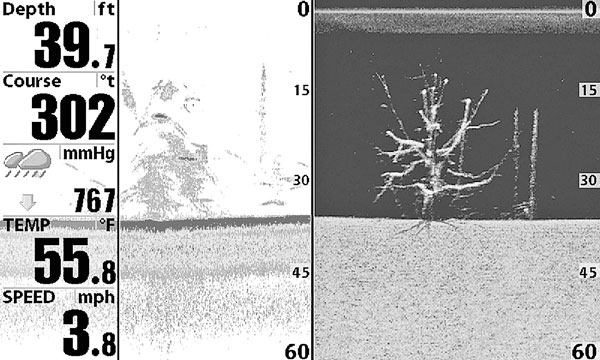
Decision on Gulf amberjack shows federal management on brink of breakdown
Thirty years ago, a state-of-the-art fish finder had a round turntable with a light bulb mounted on its edge spinning behind a clear circular window. There were hash marks and depth scale numbers printed around the window. The bulb flashed steadily at two points on the scale: one marked the water’s surface and the other its bottom. Random flashes between these two points indicated fish and structure.
Tournament fishermen and guides told me back then that it took from three to five years of steadily using a flasher to master it, and most of them could tell baitfish from weeds and brush, identify types of weeds and estimate the bottom composition, all with spooky accuracy.
Paper chart recorders came onto the recreational fishing scene next, followed by units that used LCD screens instead of paper charts. Flashers could not show screen history — they only showed echoes from their most recent sounding, and you had to watch the flashes from consecutive soundings and form a sort of screen picture in your head.
Legendary bass anglers Billy and Bobby Murray once told me that having a history of soundings on the screen instead of learning to make one in your head meant that what used to take years to learn could be taught in a couple of afternoons.
The graphic displays of traditional sonar units show fish and other suspended objects as arches and show submerged trees, brush, stumps and weeds with rounded top edges or as clusters of different-sized arches.
Yes, the coming of displays showing screen history shortened the screen interpretation learning curve, but unless you are lucky enough to have an expert with the Murray brothers’ experience as a teacher, it can take more than a couple of afternoons to get a handle on things.
Humminbird’s introduction of Side Imaging for the 2005 product year was the biggest single boost to making screen interpretation easier that I’ve seen in the 35 years I have been using fish finders. Thanks to technology more akin to medical ultrasound than traditional fish finding sonar, Side Imaging scans thin slices of water off both sides of your boat in rapid succession, and generates a screen picture that looks more like a slightly fuzzy photograph than a traditional sonar image. The “photograph” isn’t razor-sharp, but submerged trees look like trees, brush looks like brush, weeds look like weeds and virtually every submerged object is recognizable.
Lowrance introduced a similar StructureScan accessory at the February 2009 Bassmaster Classic for its HDS series units. The Lowrance system went a step further, and included a down-looking option that displays the area directly under the boat in the same picture — like detail produced by its side-looking components.
In October 2009, Humminbird announced a Down Imaging feature that integrates with Side Imaging units to also show the area directly beneath the boat with Side Imaging clarity. It is scheduled to be released as part of a free software update for Side Imaging unit owners in January 2010.
In short, thanks to the efforts of these two manufacturers, the screen interpretation learning curve has been slashed again. Since submerged objects now look like what they are, you may well be able to learn to interpret screen pictures in a couple of afternoons.
However, it’s important to understand that these systems only present picture-like views when the boat moves at a steady speed. Both companies’ systems still also present traditional down-looking sonar views that are a better choice for use at high boat speeds or for fishing while the boat is sitting still.
And learning how to read the traditional picture is easier than ever now that you can show both it and the new picture-like image side by side as you search for fish and fishy structure.


